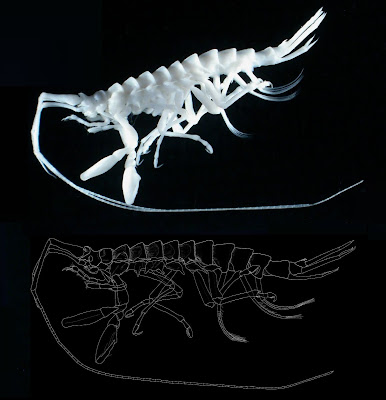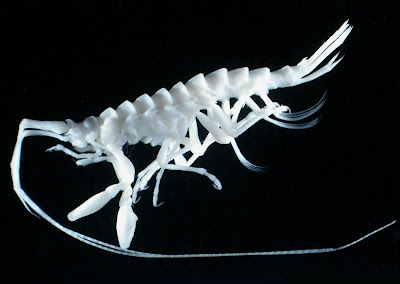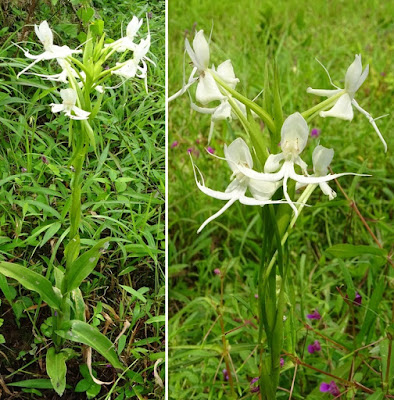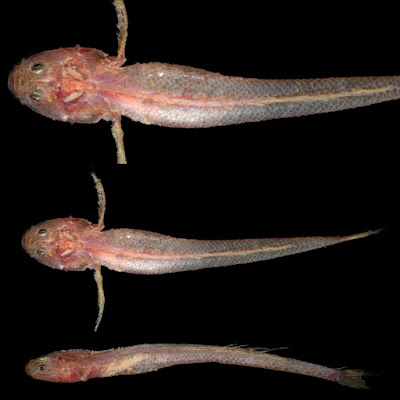[Most Recent Entries] [Calendar View]
Monday, January 27th, 2020
| Time | Event | ||||||
| 1:51p | [Crustacea • 2019] Acutocoxae ogilvieae • A New Southern Ocean Species in the Remarkable and Rare Amphipod Family Podosiridae (Crustacea: Amphipoda) questions existing Systematic Hypotheses
Abstract The amphipod family Podosiridae is unusual in that it combines morphological elements of the disparate families Podoceridae and Eusiridae. Here, we describe a new species in the family from specimens collected from the Southern Ocean in the vicinity of the South Orkney Islands and South Shetland Islands. We present mitochondrial (COI and 16S) and nuclear (18S) nucleic acid sequences for this and a congeneric species and use these to investigate the phylogenetic placement of Podosiridae within the Amphipoda. Our results do not provide evidence for a close relationship between Podosiridae and Podoceridae or Eusiridae, suggesting that the superficial similarity between these families is the result of morphological convergence. Instead, it is likely that Podosiridae are more closely related to families within Amphilochidira, such as Stenothoidae. Definitive placement of Podosiridae in the Amphipoda awaits further specimen collection, additional nucleotide data (including sequences from the Hyperiopsidae and the Vitjazianidae) and a more directed analysis of relationships within this portion of the amphipod phylogeny. Keywords: Acutocoxae ogilvieae, molecular phylogeny, South Orkney Islands
SYSTEMATICS Order Amphipoda Latreille, 1816 Suborder Hyperiopsidea Bovallius, 1886 Infraorder Hyperiopsida Bovallius, 1886 Parvorder Podosiridira Lowry & Myers, 2012 Superfamily Podosirioidea Lowry & Myers, 2012 Family Podosiridae Lowry & Myers, 2012 (amended) Debroyeridae Rauschert, 2017: 11 (nomen nudum) Genus Acutocoxae Rauschert, 2017 (amended) Type species: Acutocoxae weddellensis Rauschert, 2017. Acutocoxae ogilvieae Horton, Ashford & Thurston sp. nov. Etymology This species is named as a noun in a genitive case after the maiden name (Ogilvie) of Imogen Catherine Rachel Ashford, wife to author O.S.A. Oliver S. Ashford, Tammy Horton, Christopher N. Roterman, Michael H. Thurston, Huw J. Griffiths and Angelika Brandt. 2019. A New Southern Ocean Species in the Remarkable and Rare Amphipod Family Podosiridae (Crustacea: Amphipoda) questions existing Systematic Hypotheses. Zoological Journal of the Linnean Society. zlz145. DOI: 10.1093/zoolinnean/zlz145 New Antarctic Crustacean Species sea-technology.com/new-antarctic-crustac | ||||||
| 2:02p | [Entomology • 2020] Pseudolebinthus lunipterus • A Striking Deaf and Mute New Cricket (Orthoptera, Gryllidae, Eneopterinae) from Malawi
Abstract This article presents an intriguing new cricket species of the tribe Xenogryllini discovered in Northern Malawi. This is the first case of mute and deaf species in the subfamily Eneopterinae; it shows no stridulatory apparatus on short male forewings and no tympana on either side of fore tibiae in both sexes. We introduce the new species and its complete mitogenome and assess phylogenetic relationships based on molecular data obtained from next-generation sequencing genome skimming method. Phylogenetic analyses place the new species within the genus Pseudolebinthus in Xenogryllini, as the sister species of Pseudolebinthus gorochovi Robillard. We describe Pseudolebinthus lunipterus sp. nov., provide illustrations of main morphology, male and female genitalia, photographs of living specimens and information about habitat and update the identification key for species of genus Pseudolebinthus. We discuss the differences between the new species and related taxa and the striking loss of acoustic communication in this cricket. Taxonomy Insecta Linnaeus, 1758 Orthoptera Olivier, 1789 Gryllidae Laicharting, 1781 Eneopterinae Saussure, 1874 Xenogryllini Robillard, 2004 Genus Pseudolebinthus Robillard, 2006 Type species: Pseudolebinthus africanus Robillard, 2006 Pseudolebinthus lunipterus sp. nov. Diagnosis: Size small, mostly dark brown with pale wings (Figs. 1, 3 and 4). Among Eneopterinae genera, the new species presents the characteristics of Pseudolebinthus: large lateral eyes (Figs. 5A–5C); brachypterous FWs barely reaching quarter of abdomen length in males (Figs. 4 and 6), shorter in females where it forms pale narrow crescents (Figs. 4 and 5D); male genitalia with long sclerotized lophi, close to that of P. gorochovi (Figs. 8 and 9); female ovipositor little differentiated but less pointed and thicker than in P. gorochovi (Fig. 10A). The new species is characterized by complete absence of tympana (unique feature among eneopterines) (Figs. 7A and 7B), absence of stridulatory apparatus on male FWs (Fig. 6), abdomen ventrally yellow with a wide black stripe (Fig. 5F), thick and short female ovipositor (Fig. 4D), and differences in male genitalia, including shape of pseudepiphallic parameres, shape of sclerite in ectophallic fold and endophallic apodeme with anterior lateral expansions. Type locality. North Malawi, Mount Uzumara, ..., 1,941 m. Distribution. The species is only known from the type locality in Northern Malawi (Fig. 1C). Etymology. The species name refers to the whitish wings, rounded in males and crescent-shaped in females, which look like tiny moons on the back of the dark body of these crickets when encountered at night. Habitat and life history. Pseudolebinthus lunipterus lives on low vegetation in herbaceous areas near forest hedge or in open areas along trails in forest (Figs. 1A and 1B). Adults and juveniles have been found active at night on top of vegetation, but can also be found lower within vegetation during the day. Remarkably, the species lives in syntopy with P. gorochovi in the type locality, where adults and juveniles of both species are quite abundant. One juvenile specimen of P. lunipterus has been observed eating a dead insect on a low leaf on vegetation (Fig. 11B). Females maintained in controlled laboratory conditions (20–22 °C, 14–10 day–night cycle) with a single male produced 46–50 offspring (n = 2) during their life; first hatchings started 42–49 days after first mating and occurred on a period of 35–66 days. Conclusion: Crickets of Malawi The diversity of crickets in Eastern Africa in general, and Malawi in particular, has been underestimated, understudied and undersampled. This is at least the case for the members of the tribe Xenogryllini which were recently revised (Jaiswara, Dong & Robillard, 2018, 2019; Jaiswara et al., 2019). Despite the large amount of data considered in these systematic studies (several hundreds of specimens studied across the study of the largest natural history museum collections), they gathered very little information about the species of Pseudolebinthus, known by a few specimens each. A single recent field trip in Malawi allowed us to re-discover two of the previously described species of the genus, which are in fact common species, and it allowed documenting the acoustic features of their calling songs and their ecology (T. Robillard et al., 2020, in prep.). Interestingly, these findings allowed us to discover P. lunipterus, a completely different new species belonging to the Xenogryllini lineage, but with strikingly new morphological features. This finding reveals that more taxa probably remain unrecorded in the whole Eastern African region, as suggested by the large amount of new species and genera recently discovered in this region for other clades of orthopteran insects (Hemp et al., 2018; Hemp & Heller, 2019). More taxonomic surveys with appropriate collecting methods in regions where there is zero record about these crickets, such as other regions of Malawi, but also Zimbabwe, Zambia, Western Mozambique and Northern South Africa, are thus necessary to explore this part of African biodiversity. Karen Salazar, Raymond J. Murphy, Marion Guillaume, Romain Nattier and Tony Robillard. 2020. Pseudolebinthus lunipterus sp. nov.: A Striking Deaf and Mute New Cricket from Malawi (Orthoptera, Gryllidae, Eneopterinae). PeerJ. 8:e8204. DOI: 10.7717/peerj.8204 | ||||||
| 2:16p | [Botany • 2019] Pecteilis korigadensis (Orchidaceae: Orchidoideae) • A New Terrestrial Orchid from the northern Western Ghats, India The Western Ghats are a global biodiversity hotspot and treasure trove of biological diversity. They harbour many endemic species of flowering plants and also form an important centre of evolution of economically important domesticated plant species. Certain identified parts of the Western Ghats have been included in the UNESCO World Natural Heritage list because they are considered as cradle of evolution (MOEF&CC 2015). Although the Western Ghats cover only 5% of the country’s total land area, they also are a habitat for more than 7000 or 27% of the total plant species in India. The number of endemic plant species in the Western Ghats is estimated to be 2253 (Nayar et al. 2014).This natural landscape exhibits wide variation in rainfall coupled with complex geography, forming a vast diversity of vegetation types (Chitale et al. 2014) and supporting a rich orchid diversity. To date, 306 species of orchids have been recorded from the Western Ghats (Nayar et al. 2014), nearly one-third of them endemic. These orchids are mainly found in semi-evergreen forest, shola forest and lateritic plateaus. The Western Ghats region has been a site of intense taxonomic activity, and due to plant explorations by several researchers there has been discovery of many new species and reports (Kumar et al. 2016, Jayanthi et al. 2017). In the past fifty years (1950–2000), more than 27 species of orchids have been discovered in the Western Ghats, and the species discovery curve has not yet attained an asymptote (Aravind et al., 2007).
Pecteilis korigadensis Jalal & Jayanthi, sp. nov. Etymology:— Named after the type locality, which is well known for the famous Korigad Fort, a place of historic importance associated with Maratha ruler, Chhatrapati Shivaji Maharaj. Jeevan Singh Jalal and Jayanthi Janakiraman. 2019. Pecteilis korigadensis (Orchidaceae: Orchidoideae), A New Terrestrial Orchid from the northern Western Ghats, India. Phytotaxa. 388(2); 167–173. DOI: 10.11646/phytotaxa.388.2.3 एक नवीन आणि लक्षवेधी ऑर्किड – पेक्टिलिस कोरीगडेन्सीस baranee.in/pecteilis-korigadensis | ||||||
| 2:25p | [Ichthyology • 2020] Platygobiopsis hadiatyae • A New Species of Deepwater Gobiid (Gobiidae, Gobiinae) from east Sunda Strait, Indonesia
Abstract A new species of the gobiid genus Platygobiopsis Springer & Randall, 1992, is described based on a single specimen collected via dredge deployed at a depth range of 172 m and 182 m within the East Sunda Strait off Panaitan Island (Indonesia). The new species differs chiefly from congeners in having a scaleless (vs. scaled) chest and belly. A key to the four known species of Platygobiopsis is provided. Key words. Gobiidae, Gobiinae, Platygobiopsis, new species
Platygobiopsis hadiatyae, new species Renny’s Flat Goby Diagnosis. A very elongate, slender member of Platygobiopsis with flattened head and body, distinguished from congeners by the following combination of characters: total number of vertebrae 26; dorsal pterygiophore pattern 3-12210; sensory papillae on head in longitudinal pattern, with most papillae fleshy and forming two low fleshy ridges or folds on side of head; sensory pores on head absent; lateral scales 56; scales absent from head, predorsal, pre-pelvic area and belly; no barbels on underside of head; I,12 dorsal-fin rays; I,13 anal-fin rays; 17 pectoral-fin rays; translucent pinkish when fresh, upper part of head and body with fine dark brown speckling, fins translucent with variable brown speckling. Distribution. Indonesia, currently only known from Panaitan Strait along the Sunda Strait. Ecology. Large polychaetes, many tube worms, molluscs, crustacea, and ophiuroids came up in the dredge with the goby. The dredge started at 182 m and was lifted at 172 m (after 14 minutes of bottom time), over mud and clay bottom. Etymology. This species is named for our dear colleague Renny Kurnia Hadiaty, who died too soon (21 August 1960 to 30 January 2019). She co-authored 19 gobioid species names in addition to many other taxa. Helen K. Larson, Zeehan Jaafar, Tan Heok Hui and Teguh Peristiwady. 2020. Platygobiopsis hadiatyae, A New Species of Deepwater Gobiid from Indonesia (Teleostei, Gobiidae, Gobiinae). The Raffles Bulletin of Zoology. 68; 14-18. |
| << Previous Day |
2020/01/27 [Calendar] |
Next Day >> |
















